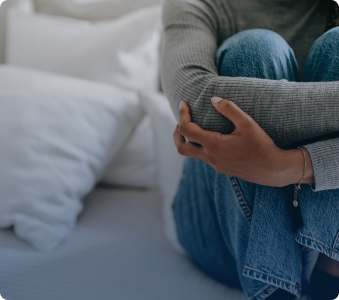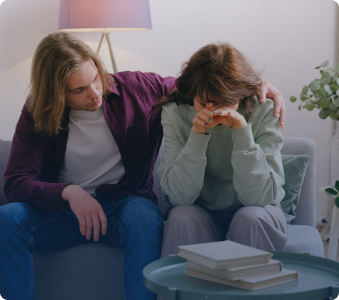Generic name: lorazepam (lor A ze pam)
- Oral tablet: 0.5 mg, 1 mg, 2 mg
- Oral solution: 2 mg/1 mL
- Injection solution: 2 mg/1 mL, 4 mg/1 mL
Brand names:
- Ativan®
- Oral tablets: 0.5 mg, 1 mg, 2 mg
- Injection solution: 2 mg/mL, 4 mg/mL
- Lorazepam Intensol®
- Oral solution: 2 mg/1 mL
- Lorazepam Novaplus®
- Injection solution: 2 mg/1 mL, 4 mg/1 mL
- Loreev XR®
- Extended-release oral capsule: 1 mg, 1.5 mg, 2 mg, 3 mg
All FDA warnings are at the end of this fact sheet. Please consult them before taking this medication.
What Is Lorazepam And What Does It Treat?
Lorazepam is a benzodiazepine. It is approved for the treatment of anxiety, insomnia, or sleep difficulty due to anxiety or stress, status epilepticus (continuous seizures), and as a medication given right before anesthesia. However, benzodiazepines can also be used to treat alcohol withdrawal.
Generalized Anxiety Disorder (GAD) occurs when a person experiences excessive anxiety or worry for at least six months. Other symptoms include:
- Restlessness
- Fatigue (low energy, feeling tired all the time)
- Difficulty concentrating
- Irritability
- Muscle tension
- Sleep disturbance (difficulty falling asleep or waking up in the middle of the night)
What Is The Most Important Information I Should Know About Lorazepam?
Do not drive a car or operate machinery until you know how this medication affects you because you may notice that you feel tired or dizzy.
When starting lorazepam, anxiety or insomnia may improve rapidly or over a period of days.
Benzodiazepines, such as lorazepam, are often used for short periods of time only. They may produce emotional and/or physical dependence (addiction) even when used as recommended. With input from you, your health care provider will assess how long you will need to take the medication.
Do not stop taking lorazepam or change your dose without talking to your health care provider first. Stopping lorazepam abruptly may result in one or more of the following withdrawal symptoms: trouble sleeping, anxiety, irritability, nausea, tremor, dizziness, blood pressure changes, rapid heart rate, and seizures. Withdrawal reactions may occur when dosage reduction occurs for any reason.
The use of lorazepam with opioid medications has led to serious side effects including slowed and difficulty breathing and death. Opioid drugs are medications used to treat pain and include medications such as: codeine, oxycodone, morphine, and illegal drugs like heroin. Some opioid medications are also found in cough syrup.
If you are taking lorazepam with an opioid medication, seek medical attention immediately if you experience unusual dizziness, extreme sleepiness, or slowed or troubled breathing. Caregivers must get medical help right away if a patient is unresponsive.
Avoid alcohol while taking this medication.
Are There Specific Concerns About Lorazepam And Pregnancy?
If you are pregnant or planning to become pregnant, notify your health care provider to best manage your medications. People living with anxiety disorders who wish to become pregnant face important decisions regarding risk versus benefit of benzodiazepine use in pregnancy. Lorazepam can increase the risk of premature birth and low birth weight. Neonatal withdrawal and “floppy baby syndrome” are other potential adverse effects. It is important to discuss this with your doctor and caregivers.
Regarding breastfeeding, caution is advised since lorazepam does pass into breast milk.
What Should I Discuss With My Health Care Provider Before Taking Lorazepam?
- Symptoms of your condition that bother you the most
- If you have thoughts of suicide or harming yourself
- Medications you have taken in the past for your condition, whether they were effective or caused any adverse effects
- If you experience side effects from your medications, discuss them with your health care provider. Some side effects may pass with time, but others may require changes in the medication.
- Any other psychiatric or medical problems you have including obstructive sleep apnea
- All other medications you are currently taking (including over the counter products and herbal and nutritional supplements) and any medication allergies you have
- Other non-medication treatment you are receiving such as talk therapy or substance abuse treatment. Your provider can explain how these different treatments work with the medication.
- If you are elderly or are prone to falls
- If you are pregnant, plan to become pregnant, or are breastfeeding
- If you drink alcohol or use drugs
How Should I Take Lorazepam?
Lorazepam may be taken with or without food. Take with food if you experience an upset stomach.
Lorazepam may be taken every day at regular times or on an as needed (“PRN”) basis. Typically, your health care provider will limit the number of doses you should take in one day.
Your health care provider will determine the dose and method of taking the medication that is right for you based upon your response.
Lorazepam liquid: Measure with a dosing spoon or oral syringe which you can get from your pharmacy.
If you take the medication every day (instead of ‘as needed’), use a calendar, pillbox, alarm clock, or cell phone alert to help you remember to take it. You may also ask a family member or friend to remind you or check in with you to be sure you are taking your medication.
What Happens If I Miss A Dose Of Lorazepam?
If you miss a dose of lorazepam, take it as soon as you remember, unless it is closer to the time of your next dose. Discuss this with your health care provider. Do not double your next dose or take more than what is prescribed.
What Should I Avoid While Taking Lorazepam?
Avoid drinking alcohol and using illegal drugs while you are taking lorazepam. They may decrease the benefits (e.g., worsen your condition) and increase the adverse effects (e.g., sedation) of the medication. Alcohol increases the risk of accidental overdose with medications like lorazepam.
What Happens If I Overdose With Lorazepam?
If an overdose occurs call your doctor or 911. You may need urgent medical care. You may also contact the poison control center at 1-800-222-1222.
Symptoms of overdose include confusion, impaired coordination, slow reflexes, coma, and death.
A specific treatment to reverse the effects of lorazepam does exist. This medication, called flumazenil, can reverse the effects of lorazepam but must be given through an IV at a hospital. Only a doctor can decide if you need this medication.
What Are The Possible Side Effects Of Lorazepam?
Common side effects
- Feeling dizzy, drowsy, fatigued, or lightheaded
- Impaired coordination, decreased ability to concentrate
If you experience these side effects after starting lorazepam they will often improve over the first week or two as you continue to take the medication. If side effects do not improve or become problematic, consult your health care provider.
Rare/Serious side effects
Shortness of breath, trouble speaking, feeling very tired, dizziness, or passing out.
Increased heart rate, headache, memory impairment, irritability, and restlessness may occur.
Some people taking benzodiazepines develop a severe allergic reaction and swelling of the face. This can occur as early as with the first dose.
Some people taking benzodiazepines for sleep have experienced various behaviors while they were asleep/not fully awake, such as sleep driving, making phone calls, and preparing or eating food. The individuals have no memory of the events when they awaken.
Signs of feeling depressed or low mood, thoughts of harming or killing yourself, or lack of interest in life.
Are There Any Risks For Taking Lorazepam For Long Periods Of Time?
Lorazepam is a safe and effective medication when used as directed. Benzodiazepines may produce emotional and/or physical dependence (addiction) even when used as recommended. Physical dependence may develop after 2 or more weeks of daily use. The risk of withdrawal reactions when stopping therapy with lorazepam is increased with prolonged use of the medication.
What Other Medications May Interact With Lorazepam?
Lorazepam should not be taken with other benzodiazepine medications.
Lorazepam causes drowsiness, so caution should be used when combining it with other medications that cause drowsiness. These could include:
- Antihistamines such as diphenhydramine (Benadryl®)
- Narcotic pain medication such as morphine, oxycodone (OxyContin®), and hydrocodone (Vicodin® and Lortab®)
- Opioid cough medications such as codeine cough syrup
- Sleeping medications such as zolpidem (Ambien®)
- Other anti-anxiety medications, antipsychotic medications, certain anticonvulsant medications, and tricyclic antidepressant medications (such as amitriptyline)
How Long Does It Take For Lorazepam To Work?
When starting lorazepam, anxiety or insomnia may improve rapidly or over a period of days or within hours of the first dose of medication.
Summary of Black Box Warnings
The FDA has found that benzodiazepines, such as lorazepam, when used in combination with opioid medications or other sedating medications can result in serious adverse reactions including slowed or difficult breathing and death. Patients taking opioids with benzodiazepines, other sedating medications, or alcohol, and caregivers of these patients, should seek immediate medical attention if that start to experience unusual dizziness or lightheadedness, extreme sleepiness, slow or difficulty breathing, or unresponsiveness.
As a benzodiazepine, lorazepam comes with the risk of abuse, misuse, and addiction to the medication. Physical dependence to lorazepam can occur with prolonged use of the medication. A withdrawal reaction may occur when stopping lorazepam, but this risk can be reduced by slowly reducing the dose of lorazepam when stopping. Do not stop taking lorazepam abruptly, and do not make any changes to therapy without consulting your health care provider.
Last Reviewed: January 2024
Provided by

Important Disclosure: This information is being provided as a community outreach effort of the American Association of Psychiatric Pharmacists. This information is for educational and informational purposes only and is not medical advice. This information contains a summary of important points and is not an exhaustive review of information about the medication. Always seek the advice of a physician or other qualified medical professional with any questions you may have regarding medications or medical conditions. Never delay seeking professional medical advice or disregard medical professional advice as a result of any information provided herein. The American Association of Psychiatric Pharmacists disclaims any and all liability alleged as a result of the information provided herein.
©2023 The American Association of Psychiatric Pharmacists (AAPP) and the National Alliance on Mental Illness (NAMI). AAPP and NAMI make this document available under the Creative Commons Attribution-NoDerivatives 4.0 International License. Last Updated: January 2016.

